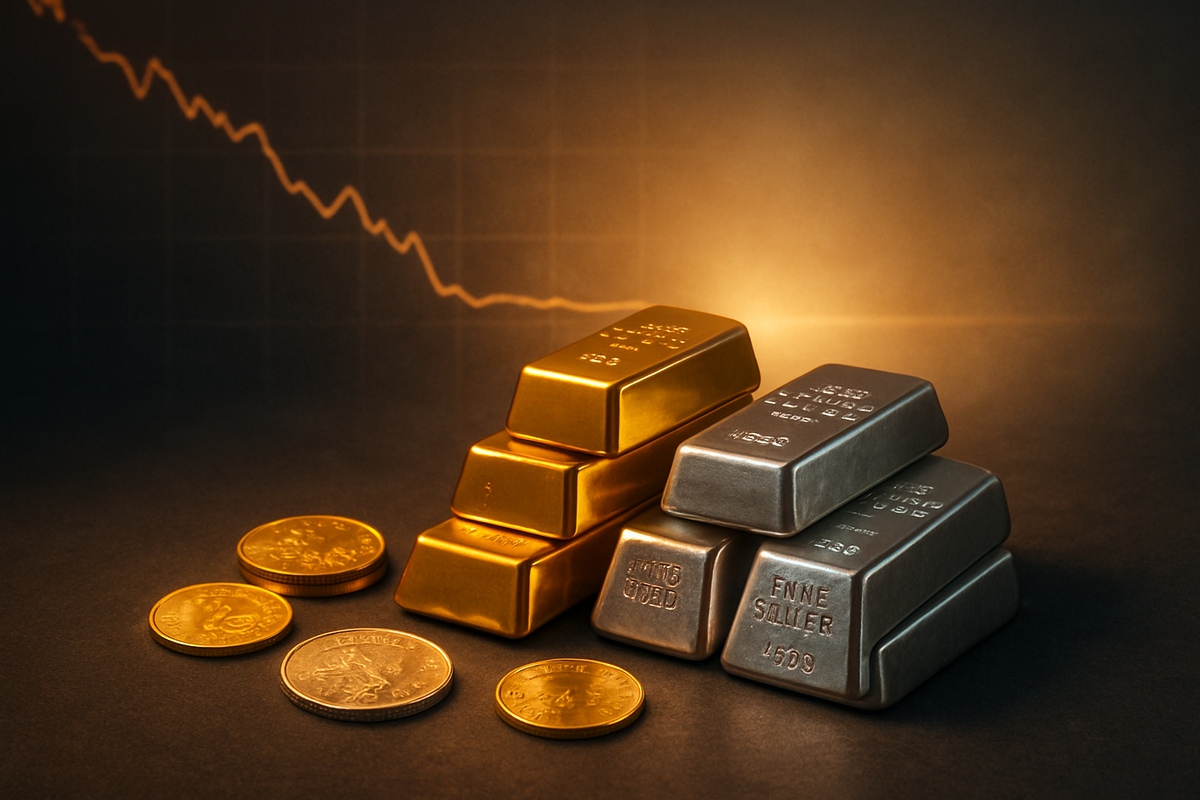
The precious metals market, after a period of exhilarating rallies that saw gold and silver reach historic highs in early October 2025, recently experienced dramatic and sharp corrections. As of late October 2025, prices appear to be finding a footing and showing signs of stabilization, prompting a critical assessment among market participants. This pivotal moment raises a crucial question: Is this merely a temporary reprieve, a healthy technical correction within a continuing bull market, or does it signal the dawn of a new, structurally shifting phase for gold and silver in the global financial landscape?
The dramatic swings witnessed throughout October have underscored the inherent volatility of these assets, even as their long-term appeal as safe havens and inflation hedges remains strong. Investors, central banks, and industry observers are now closely watching to discern whether the recent declines and subsequent stabilization present a strategic 'buy the dip' opportunity or if the market is recalibrating for a more measured, yet potentially profound, new chapter. The answer holds significant implications for portfolio diversification, wealth preservation, and the broader global economy.
A Wild October Ride: From Record Highs to Sharp Corrections
The year 2025 had been a banner year for precious metals, with gold surging over 50% to breach the $4,000 per ounce mark on October 7, and peaking at an unprecedented $4,379 per ounce by October 17. U.S. gold futures even touched a record $4,391.69 per ounce. Silver mirrored this spectacular ascent, also gaining over 50% in the first nine months and hitting a 14-year high above US$44 by September 22, before reaching an all-time intraday high of $54.47 per ounce on October 17. This meteoric rise, however, proved unsustainable.
The latter half of October brought a sharp reversal. On October 21, gold experienced its largest single-day percentage decline in over a decade, plummeting by as much as 6.3% from its peak to approximately $4,106 per troy ounce. Silver followed suit, retreating by nearly 9% to $48.50 per ounce, marking its steepest decline since February 2021. These losses extended into October 22, reflecting a widespread market correction. Domestically, in India, gold prices corrected from ₹1.3 lakh per 10 grams to roughly ₹1.25 lakh, with silver slipping around 12% since October 18, 2025.
Several converging factors fueled this dramatic downturn. Primarily, a wave of profit-taking ensued after the metals entered "overbought" territory, with traders cashing in on substantial gains. Concurrently, easing US-China trade tensions, with President Donald Trump expressing optimism about a "fair" deal with Chinese President Xi Jinping, diminished gold's safe-haven appeal and bolstered broader market risk appetite. A strengthening US dollar further exacerbated the decline, making dollar-denominated gold and silver more expensive for international buyers. Analysts widely characterized the declines as a "technical correction" after an unsustainably rapid rally.
Despite the sharp drops, investor reactions have been nuanced. While widespread profit-taking was evident, a "divergence in market perception" emerged. Many analysts and long-term investors viewed the correction as a "buy the dip" opportunity, especially for those previously underweight in precious metals. Notably, central banks from emerging economies continue their aggressive accumulation of gold, signaling a strategic pivot away from U.S. dollar dominance. Retail investors, too, are increasingly turning to physical bullion and coins as alternatives to volatile digital assets and equities, seeking stability amidst inflation concerns and currency fluctuations.
Corporate Fortunes in the Balance: Winners and Losers from Price Stability
The stabilization of gold and silver prices, particularly after the significant volatility of early October 2025, is poised to reshape the fortunes of public companies across the mining, refining, and investment sectors. While the preceding rally brought substantial windfalls, a more predictable price environment introduces a new set of strategic considerations. Generally, stabilization at current elevated levels fosters improved financial planning, potentially reduces costly hedging strategies for producers, and facilitates long-term investment, leading to more stable margins across the value chain.
In the mining sector, low-cost producers stand to be the primary beneficiaries. Companies with efficient operations and low "all-in sustaining costs" (AISC) would see robust profit margins locked in, enabling sustained cash flow, enhanced shareholder returns, and strategic growth. Giants like Newmont Corporation (NYSE: NEM), the world's largest gold miner, and Barrick Gold Corporation (NYSE: GOLD) are well-positioned to capitalize on stable, high prices, continuing their strong dividend and share repurchase programs. Similarly, Agnico Eagle Mines Limited (NYSE: AEM, TSX: AEM), known for its low-risk operations, and leading silver producers such as Pan American Silver Corp. (NASDAQ: PAAS, TSX: PAAS) and First Majestic Silver Corp. (NYSE: AG, TSX: AG) would thrive, leveraging their substantial reserves and focus on financial strength. Diversified miners like Boliden AB (STO: BOL), which saw precious metals become critical profit drivers, would also benefit from predictable revenue streams.
Streaming and royalty companies are also poised for significant gains. Their business model, which involves providing upfront capital to miners in exchange for future production at fixed, often low, prices, or a percentage of revenue, carries lower operational risk. With stable, high commodity prices, companies like Wheaton Precious Metals Corp. (NYSE: WPM, TSX: WPM), Franco-Nevada Corporation (NYSE: FNV, TSX: FNV), and Royal Gold Inc. (NASDAQ: RGLD) would maximize the spread between their acquisition costs and market prices, leading to substantial and predictable profits. Conversely, high-cost producers, whose AISC are close to or exceed the stabilized price levels, would face severe profit margin compression, potentially leading to operational cutbacks or project deferrals. Pure-play exploration companies might also find it harder to attract speculative capital if the "boom" cycle's rapid upside diminishes.
The refining and investment sectors would also see shifts. Established refiners and bullion dealers, such as A-Mark Precious Metals, Inc. (NASDAQ: AMRK), would benefit from more efficient inventory management, reduced valuation risks, and predictable operational margins, mitigating the "volatile market conditions" they experienced in Q3 FY2025. In the investment realm, physical precious metals ETFs like Sprott Physical Gold and Silver Trust (NYSE: CEF, TSX: CEF), SPDR Gold Shares (NYSEARCA: GLD), and iShares Silver Trust (NYSEARCA: SLV) would appeal to a broader base of long-term investors seeking wealth preservation rather than just short-term speculative gains. Conversely, highly speculative funds and traders whose strategies rely on extreme price volatility for arbitrage opportunities might see their avenues for profit diminish.
Broader Implications: A Shifting Financial Landscape
The stabilization of gold and silver prices, particularly after the dramatic swings of October 2025, carries profound wider significance, influencing broader industry trends, creating ripple effects across related sectors, and potentially shaping regulatory and monetary policies. This event is not merely a market adjustment but a reflection of deeper economic and geopolitical currents.
In the broader industry landscape, stable and elevated precious metal prices translate into sustained profitability for the mining sector. This predictability allows for long-term planning, increased exploration budgets, and development of new projects, which might have been deferred during extreme volatility. For the investment and financial markets, gold and silver's role as safe-haven assets and hedges against inflation and currency debasement is reinforced. The continued aggressive accumulation of gold by central banks globally, signaling de-dollarization efforts and a strategic pivot, provides a structural floor for prices and underscores a tectonic shift in the global financial system towards a multi-polar, asset-backed model.
Silver's dual role as both a monetary metal and a critical industrial commodity means its stabilization has distinct ripple effects. Strong industrial demand from burgeoning green technologies like solar energy, electronics, and electric vehicles provides a structural floor for silver prices. While stabilization at higher levels could increase input costs for these industries, it also provides a consistent pricing environment, fostering long-term investment in these critical sectors. For the jewelry industry, stable, higher prices mean increased raw material costs but also a higher value for existing inventory, enabling more consistent pricing strategies.
From a regulatory and policy perspective, the sustained appeal and stabilization of precious metals could influence central bank monetary policies. Expectations of aggressive monetary easing and interest rate cuts by central banks, such as the Federal Reserve's anticipated rate reductions throughout 2025, significantly boost the appeal of non-yielding assets like gold and silver. Their stabilization might indicate that these policies are having their desired effect on inflation and economic stability, or it could prompt central banks to reassess their policy trajectory. Given silver's role in green technologies, stable prices could also inform government policies related to renewable energy and critical mineral supply chains. Historically, gold and silver have consistently served as safe havens during crises, and the current stabilization, following a period of intense rally, echoes past cycles where corrections were seen as healthy adjustments within a broader bullish trend, rather than an end to it.
The Road Ahead: Navigating a Dynamic Precious Metals Market
The stabilization of gold and silver prices after the October 2025 corrections sets the stage for a dynamic period ahead, characterized by both opportunities and challenges. In the short term (late 2025 - early 2026), volatility is expected to persist, with analysts generally advocating a "buy the dips" strategy. Gold is anticipated to consolidate around the $4,000-$4,100 per ounce range, with potential to retest $4,220–$4,280 if it breaks above $4,185. Silver, after its sharp correction, is likely to consolidate around $50-$55 per ounce, with eyes on breaking above $50 for sustained upward momentum. Key short-term drivers will include U.S. inflation data, central bank interest rate decisions (with further rate cuts anticipated), and evolving geopolitical landscapes.
Longer term (2026 and beyond), the outlook for both metals remains robustly bullish, with projections for continued appreciation driven by fundamental macroeconomic and geopolitical factors. Gold is projected to average $4,500 per ounce in 2026-2027 by some institutions, with more aggressive forecasts from major banks like Goldman Sachs and Bank of America anticipating $4,900-$5,000 by mid-2026, and even $6,000-$6,500 by 2027. Some long-term projections even extend to $10,000 by 2030, driven by global debt and currency debasement concerns. Silver is also expected to maintain strong bullish momentum, with projections of $65 per ounce by the end of 2026 and potentially $200-$250 by 2030-2035. This sustained appreciation is underpinned by ongoing macroeconomic uncertainty, persistent investor hedging, and for silver, robust industrial demand from green energy and electronics sectors.
Strategic pivots for investors will involve continuing to "buy the dips," diversifying portfolios with increased exposure to silver-backed ETFs or physical bullion alongside core gold holdings, and implementing robust risk management strategies to navigate heightened volatility. For mining companies, this period demands optimizing existing operations, exploring new silver-rich deposits, and expanding by-product recovery from base metal mines. While opportunities abound in continued appreciation and the potential for post-correction rebounds, challenges include sustained U.S. dollar strength, potential easing of geopolitical tensions, increased input costs for reliant industries, and the inherent liquidity differences of silver, which can magnify price swings.
A Resilient Future for Precious Metals
The dramatic corrections experienced by gold and silver in October 2025, followed by their current stabilization, represent a critical juncture for the precious metals market. The key takeaway is that these sharp declines are largely viewed as a "healthy and necessary correction" within a continuing long-term bullish trend, rather than an end to it. The underlying structural forces—including persistent inflation concerns, ongoing central bank diversification away from the U.S. dollar, and robust industrial demand for silver—remain firmly in place and are expected to intensify, providing a strong foundation for future price appreciation.
Moving forward, the market assessment points to a resilient future for gold and silver. Gold's ability to consolidate around the $4,000-$4,100 level post-correction, coupled with strong central bank accumulation, underscores its enduring role as a safe-haven asset. Silver, despite its higher volatility, is positioned for significant long-term growth due to its dual monetary and industrial appeal, particularly from the burgeoning green economy sectors. Many experts believe both metals are currently "under-owned" in investor portfolios, suggesting substantial room for renewed interest and strategic accumulation.
The lasting impact of this period will likely be a market that anticipates and adapts to a higher baseline volatility, yet one that recognizes the increasing importance of precious metals in a diversifying global financial landscape. Investors should closely watch Federal Reserve monetary policy, particularly further anticipated interest rate cuts, and evolving inflation trends. Geopolitical developments, the trajectory of the U.S. dollar, and central bank purchasing patterns will also be crucial indicators. For silver, continued growth in industrial demand from "green economy" sectors will be a significant long-term driver. While short-term fluctuations are expected, the long-term outlook for both gold and silver remains robustly bullish, making them compelling assets for strategic portfolio diversification in the coming months and years.
This content is intended for informational purposes only and is not financial advice




